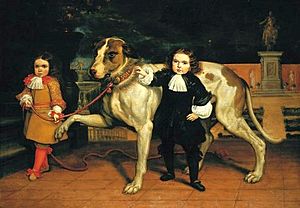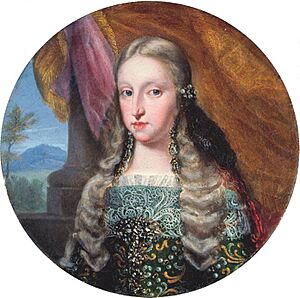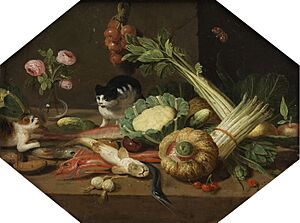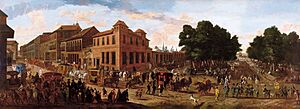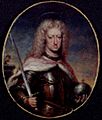Jan van Kessel the Younger facts for kids

Jan van Kessel the Younger (born in Antwerp, 23 November 1654 – died in Madrid, 1708) was a Flemish painter. He is also known as Jan van Kessel II. After learning to paint in Antwerp, he moved to Spain. He became famous for his portraits and worked as a court painter for the King and Queen of Spain. He also painted some landscapes and scenes from myths or stories, but he is mostly known for his portraits.
Contents
Life of Jan van Kessel the Younger
Jan van Kessel the Younger was born in Antwerp. His father was Jan van Kessel the Elder, who was also a painter. Jan the Younger came from a very famous family of painters called the Brueghel family. His great-great-grandfather was Pieter Brueghel the Elder, and his great-grandfather was Jan Brueghel the Elder. Many people in his family were artists! His brother, Ferdinand van Kessel, was also a painter.
Jan van Kessel the Younger probably learned to paint from his father. Instead of staying in Antwerp, he moved to Madrid, Spain, around 1679. In Madrid, he became a painter for the royal court. He quickly became well-known for his portraits.
He became popular at court during the time of King Charles II of Spain. He painted many portraits of the Queen, Marie Louise d'Orléans, who was Charles II's first wife. In 1686, he officially became the Queen's painter. People say the Queen asked him to paint scenes on the ceiling of her rooms in the Royal Alcazar of Madrid. After Queen Marie Louise died, Jan van Kessel kept working as a portrait painter for the King. He also became a favorite of the King's new wife, Maria Anna of Neuburg.
When a new royal family, the Bourbons, took over in Spain in 1700, Jan van Kessel's popularity at court started to fade. This was probably because he stayed close to the old Queen, Maria Anna, even when she was sent away to Toledo. He didn't go with her when she moved to Bayonne in 1706 because he was not well. Instead, he went back to Madrid. The new king, Philip V of Spain, might not have liked his work as much. This could be because French styles were becoming more popular at the Bourbon court. By this time, Jan van Kessel had become quite wealthy.
He is thought to have died in Madrid in 1708.
What Jan van Kessel Painted
Types of Paintings
Jan van Kessel is said to have painted many different things. These include portraits, flower paintings, still lifes (pictures of objects), hunting scenes, and landscapes. However, some art experts are not sure if he painted all of these types of pictures. It can be confusing because there were other painters named Jan van Kessel around at the same time! For example, his father was also named Jan van Kessel. There was also another painter in Antwerp called "the other" Jan van Kessel, and a landscape painter in Amsterdam named Jan van Kessel.
Because Jan van Kessel the Younger rarely signed his paintings, experts have had to figure out which paintings are his by looking at his style.
Portraits
As a court painter, Jan van Kessel's main job was to paint portraits of the royal family, especially the Queen. His style was said to be very similar to another famous Flemish painter, Anthony van Dyck. When he first arrived in Spain, he seemed to follow the style of royal portraits set by Spanish painters like Diego Velázquez. These portraits were simple, with few objects or symbols, and often had a plain background.
You can see this Spanish influence in the Portrait of Maria Anna of Neuburg (around 1690). But later, he changed his style. In another Portrait of Maria Anna of Neuburg, he added more color and a view of a landscape in the background. This painting goes with a Portrait of Charles II of Spain. These two oval paintings were originally part of a bigger square painting that had flower garlands around them. He also used bright colors and played with light and shadow in his Portrait of Maria Nicolasa de la Cerda (around 1685). Some portraits are thought to be his because they look like his signed works. For example, the Portrait of Marie Louise d’Orléans is believed to be by him, even though the Prado Museum still lists it as by an unknown painter.
Jan van Kessel was also good at painting group portraits. A great example is the Portrait of a family in a garden in the Prado Museum. This painting shows a Flemish gentleman and his family. The painting is meant to celebrate family life and good family values like loyalty. The man playing the guitar shows family harmony, and the dog shows loyalty. The older woman with small children shows kindness, and the young couple holding hands shows married love. The painting even includes a self-portrait of the artist himself, peeking out of a window in the background! A slightly different version of this painting is in the National Museum in Warsaw.
He also painted small portraits. These were very popular with rich people at the time. They were like personal treasures that people would give to family and friends. They were less formal than official portraits and easy to carry around to remember loved ones. One of his first known small portraits was of King Charles II (now lost). The King gave it to his wife, Maria Anna of Neuburg, as a wedding gift. Another example is a pair of small portraits of Charles II of Spain and Maria Anna of Neuburg (in the Abelló Collection, Madrid). These are less formal than his official portraits.
Two other small portraits of the royal couple are in the Lázaro Galdiano Museum. They were probably made to be sent to Russia as a gift, as the king is shown wearing armor. In another pair of small portraits (from 1696-1700), Charles II of Spain is shown as Saint Ferdinand, and Maria Anna of Neuburg is shown as Saint Helena. There are also two small portraits of the royal couple in the Museo Nacional de Artes Decorativas in Madrid. He also painted two small portraits of Philip V of Spain and his wife Maria Luisa of Savoy around 1701, which are in the Real Academia de la Historia in Madrid.
Still Lifes
While some art experts wonder if Jan van Kessel the Younger painted still lifes, many such paintings have been linked to him. These still lifes are similar to those painted by his father. They are well-balanced pictures with lots of detail and soft colors. It's thought that his Flemish style of still life painting slowly started to include some features of the Spanish style.
However, many still life paintings that were once thought to be by Jan van Kessel the Younger are now believed to be by another artist or workshop called Pseudo-Jan van Kessel the Younger. This "Pseudo-Jan van Kessel the Younger" is a name given to an unknown artist or group who painted about 200 small still lifes in Southern Europe. The few paintings that are definitely known to be by Jan van Kessel the Younger are different in style and much higher quality than the works now given to Pseudo-Jan van Kessel the Younger.
Landscapes
An old writer named Antonio Palomino said that van Kessel was also a skilled landscape artist. But no landscape paintings are definitely known to be by him. One painting, a view of a street in Madrid called View of the Carrera de San Jerónimo and the Paseo del Prado with a Procession of Carriages (Thyssen-Bornemisza Museum, Madrid), is thought to possibly be by him.
Other Subjects
Jan van Kessel's father, great-grandfather, and great-uncle all painted many different subjects, including scenes from myths and stories. Jan van Kessel the Younger is also thought to have painted such works. For example, the Venus in the forge of Vulcan and the Allegory of Earth (which he painted with Abraham Willemsens) are believed to be his. These paintings show that he continued his family's traditions. They also show how artists in Antwerp often worked together, with different artists painting different parts of a picture. In these two paintings, the people were painted by other artists who specialized in figures, not by van Kessel himself.
Images for kids
See also
 In Spanish: Jan van Kessel II para niños
In Spanish: Jan van Kessel II para niños


